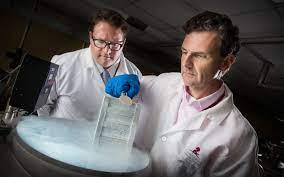Introduction
A groundbreaking discovery by researchers from St. Jude Children’s Research Hospital and collaborating institutions offers new hope in the fight against influenza, a virus notorious for its severe impact on the lungs and overall health. Published in Nature, their latest study introduces a novel drug that effectively balances controlling harmful inflammation and allowing the immune system to combat the virus effectively.

The Challenge of Influenza
Influenza infections can lead to severe lung damage and life-threatening conditions due to over-activation of inflammatory responses in the body. This overreaction not only combats the virus but also harms essential cells needed for breathing. Traditional treatments have focused on attacking the virus early in the infection process, but often, by the time patients seek help, it’s too late for these treatments to be effective.
A New Approach to Influenza Treatment
The collaborative effort involving St. Jude Children’s Research Hospital, the University of Houston, Tufts University School of Medicine, and Fox Chase Cancer Center has led to the development of UH15-38, a drug that prevents severe lung injury induced by the flu. What sets UH15-38 apart is its ability to suppress excessive inflammatory responses without compromising the body’s ability to fight the virus.
Study Findings and Implications
In a series of experiments conducted on mouse models, UH15-38 showed remarkable efficacy in protecting against lethal doses of influenza, akin to those that humans face during severe infections. Impressively, the drug was effective even when administered several days after the initial infection, a significant breakthrough given that most antiviral drugs must be given early to work effectively.
“UH15-38 can also do something we’ve never seen before,” stated Paul Thomas, Ph.D., a senior researcher involved in the study. This ability to intervene later in the infection process could be crucial for treating patients who do not seek immediate care.
Mechanism of Action
The drug works by selectively inhibiting a specific part of the inflammation pathway in immune cells. By targeting Receptor-Interacting Protein Kinase 3 (RIPK3), which controls the cell death pathways known as apoptosis and necroptosis, UH15-38 prevents the highly inflammatory necroptosis while allowing apoptosis. This approach reduces inflammation and lung tissue damage while preserving the immune system’s ability to clear the virus.
Clinical and Future Potential
The significant reduction in inflammation and preservation of lung cells underline the drug’s potential as a superior treatment option. Not only does it prevent the destruction of Type 1 alveolar epithelial cells, crucial for oxygen exchange in the lungs, but it also decreases the presence of inflammation-related immune cells like neutrophils in the lungs.
“This drug has shown that we can dampen the inflammation caused by influenza while leaving other vital immune responses intact,” Thomas explained. Such capabilities make UH15-38 a promising candidate for clinical trials and eventual widespread use in flu treatment.
Conclusion
The development of UH15-38 could represent a paradigm shift in how influenza is treated, particularly in severe cases where current therapies fall short. By providing a way to effectively manage inflammation while supporting the body’s viral defense, this drug could significantly reduce the morbidity and mortality associated with influenza. The researchers plan to continue their investigations into how this drug could be integrated into existing treatment protocols and its potential applications in other inflammatory diseases.